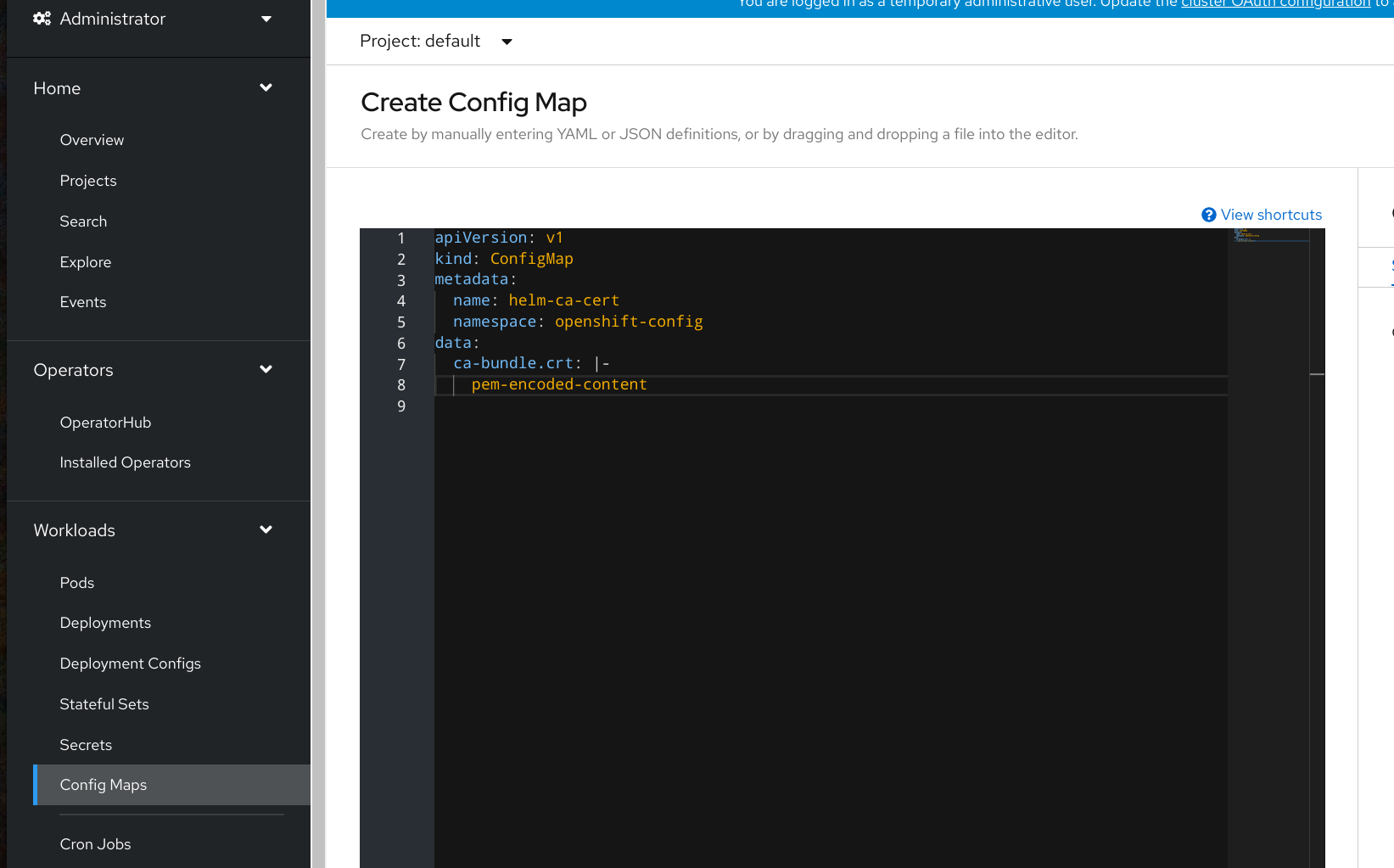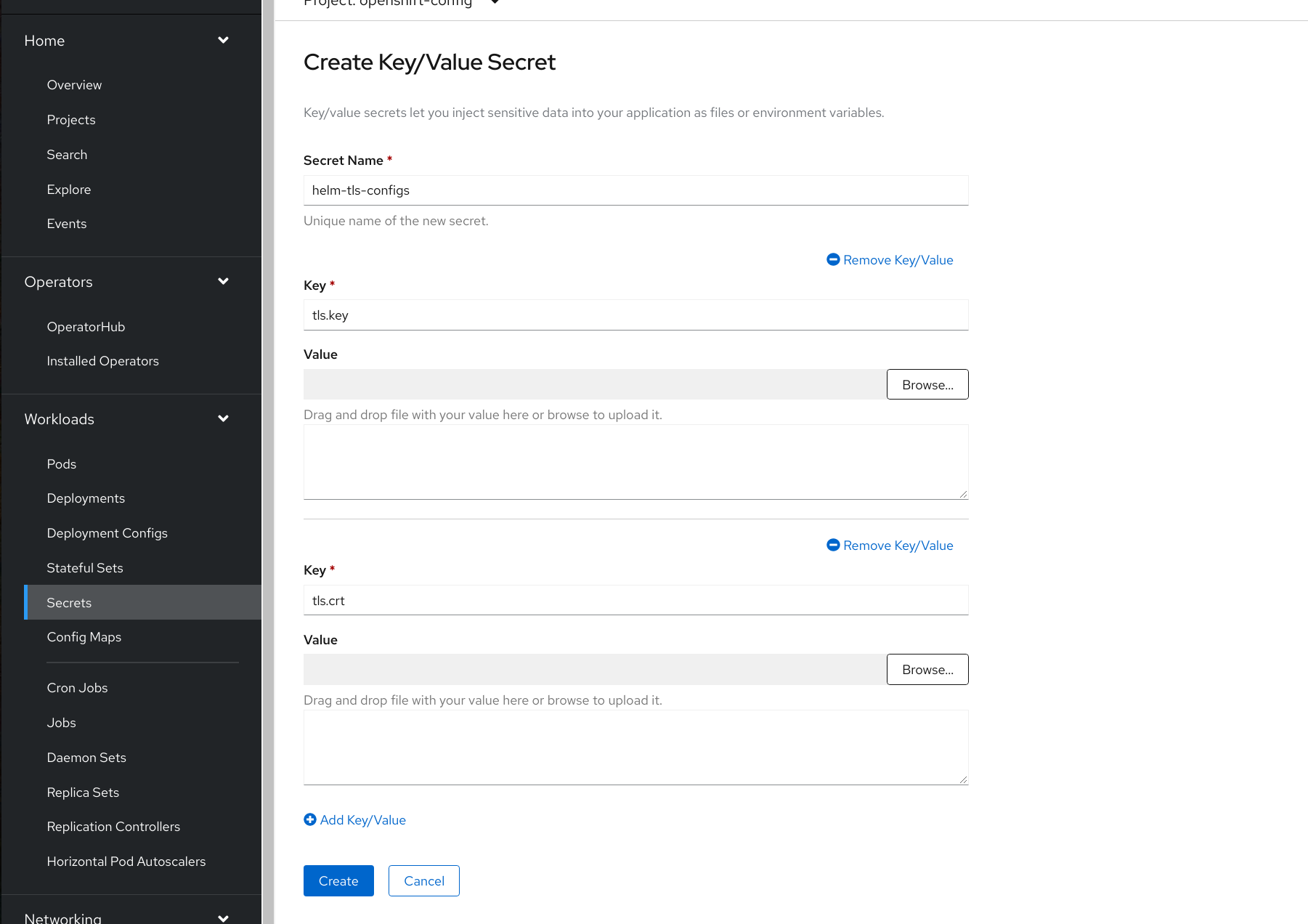Configure Access to 3rd Party Chart Repositories in Openshift Console.
Default Chart Repository
Openshift console by default lists Helm charts from RedHat Helm chart repository.
Replace Default with 3rd-party Repository
Instances of HelmChartRepository CRD
capture the details required for accessing a Helm chart repository.
Basic structure of HelmChartRepository CR
apiVersion: helm.openshift.io/v1beta1
kind: HelmChartRepository
metadata:
name: NAME
spec:
# optional name that might be used by console
# name: CHART_DISPLAY_NAME
connectionConfig:
url: HELM_CHART_REPO_URL
Add Azure Sample Chart Repository
$ cat <<EOF | kubectl apply -f -
apiVersion: helm.openshift.io/v1beta1
kind: HelmChartRepository
metadata:
name: azure-sample-repo
spec:
connectionConfig:
url: https://raw.githubusercontent.com/Azure-Samples/helm-charts/master/docs
EOF
Configure CA certificates
If accessing chart repository requires usage of a custom CA certificate, its content (PEM encoded) needs be
stored under key ca-bundle.crt within the configmap in openshift-config namespace. The configmap name
is referred in spec.connectionConfig.ca.name field.
spec:
connectionConfig:
url: https://my-private-repo.foo.local
ca:
name: helm-ca-cert
Configmaps can be added through UI:
or from CLI:
kubectl create configmap helm-ca-cert \
--from-file=ca-bundle.crt=/path/to/certs/ca.crt \
-n openshift-config
Configure Client TLS Configurations
Similarly, client certificate and key can be provided for cases when the repo requires them.
These should be in pem encoded format and stored under key tls.crt and tls.key respectively,
within a secret in openshift-config namespace. The secret name is referred in spec.connectionConfig.tlsClientConfig.name
field.
spec:
connectionConfig:
url: https://my-private-repo.foo.local
tlsClientConfig:
name: helm-tls-configs
Secrets can be added through UI:
or from CLI:
kubectl create secret generic helm-tls-configs \
--from-file=tls.crt=/path/to/certs/client.crt \
--from-file=tls.key=/path/to/certs//client.key \
-n openshift-config
Disable Helm chart repository
We can disable listing helm charts in the catalog by adding disabled flag.
spec:
connectionConfig:
url: https://my-private-repo.foo.local
disabled: true
By adding disabled flag in the CR, we are disabling helm chart listing from https://my-private-repo.foo.local repository.
Multiple Chart Repository Support
Adding multiple instances of HelmChartRepository is supported. As the result, /api/helm/charts/index.yaml
endpoint returns combined chart list, containing charts from all accessible repositories.
Access Control
When requesting repo index through /api/helm/charts/index.yaml endpoint, HelmChartRepository CRs and
corresponding configmaps and secrets are read on behalf of logged UI user. By default, only admins have
proper rights. Without that, users see only charts from the default repo. Admins might allow others to
browse configured repo by adding appropriate roles to the cluster.
Example: allow all regular users to browse repos:
$ cat <<EOF | kubectl apply -f -
kind: ClusterRole
apiVersion: rbac.authorization.k8s.io/v1
metadata:
name: helm-chartrepos-viewer
rules:
- verbs:
- get
- list
apiGroups:
- helm.openshift.io
resources:
- helmchartrepositories
---
kind: ClusterRoleBinding
apiVersion: rbac.authorization.k8s.io/v1
metadata:
name: helm-chartrepos-view
subjects:
- kind: Group
apiGroup: rbac.authorization.k8s.io
name: 'system:authenticated'
roleRef:
apiGroup: rbac.authorization.k8s.io
kind: ClusterRole
name: helm-chartrepos-viewer
EOF
In case when certificates are needed, additional appropriate roles must
be added in openshift-config namespace.
Following the previous example, regular users need to
get read access to helm-ca-cert configmap and helm-tls-configs secret.
$ cat << EOF | kubectl apply -f -
apiVersion: rbac.authorization.k8s.io/v1
kind: Role
metadata:
namespace: openshift-config
name: helm-chartrepos-tls-conf-viewer
rules:
- apiGroups: [""]
resources: ["configmaps"]
resourceNames: ["helm-ca-cert"]
verbs: ["get"]
- apiGroups: [""]
resources: ["secrets"]
resourceNames: ["helm-tls-configs"]
verbs: ["get"]
---
kind: RoleBinding
apiVersion: rbac.authorization.k8s.io/v1
metadata:
namespace: openshift-config
name: helm-chartrepos-tls-conf-viewer
subjects:
- kind: Group
apiGroup: rbac.authorization.k8s.io
name: 'system:authenticated'
roleRef:
apiGroup: rbac.authorization.k8s.io
kind: Role
name: helm-chartrepos-tls-conf-viewer
EOF
Applying carefully crafted roles, an admin can really fine tune access to declared repos, even achieve different views for appropriate user groups, etc.

